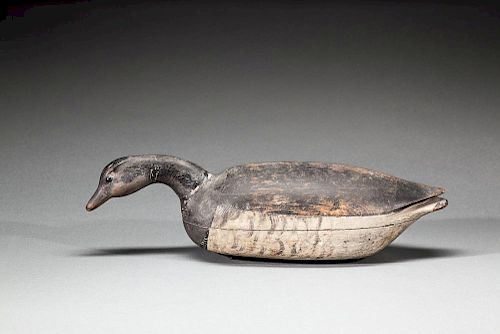Feeding Brant
About Seller
20 Winter Street
Pembroke, MA 02359
United States
Founded in 2005, Copley Fine Art Auctions is a boutique auction house specializing in antique decoys and American, sporting, and wildlife paintings. Over the course of the last two decades, the firm has set auction records for not only individual decoy makers, but also entire carving regions. Copley...Read more
Two ways to bid:
- Leave a max absentee bid and the platform will bid on your behalf up to your maximum bid during the live auction.
- Bid live during the auction and your bids will be submitted real-time to the auctioneer.
Bid Increments
| Price | Bid Increment |
|---|---|
| $0 | $50 |
| $1,000 | $100 |
| $2,500 | $250 |
| $5,000 | $500 |
| $10,000 | $1,000 |
| $25,000 | $2,500 |
| $50,000 | $5,000 |
About Auction
Jul 25, 2015 - Jul 26, 2015
Copley Fine Art Auctions cinnie@copleyart.com
- Lot Description
Nathan F. Cobb, Jr. (1825-1905), Cobb Island, VA, c. 1880
Cobb Island is known to have produced some of the most animated brant decoys ever carved. This may be due in part to a special affinity for the species that the islanders showed. Nathan Cobb, Sr. maintained a tame flock of brant on the island that were a local attraction and even once collateral for hotel construction loans.
This important decoy is documented in Eugene V. Connett?s 1947 masterwork ?Duck Shooting Along the Atlantic Tidewater.? Numerous prominent figures in the early decoy and sporting art community contributed to this volume with chapters written by A. Elmer Crowell, Charles E. ?Shang? Wheeler, and Lynn Bogue Hunt. The ?Eastern Shore of Virginia? chapter was penned by Richard L. Parks, a previous owner of this decoy. Parks dedicates much of his chapter to the Cobbs? story, which was told to him directly by two of Nathan, Jr?s nephews, Lucius (1870-1947) and Arthur Cobb (1870-1951), who were born and raised on the island. Parks writes that ?...they and their fathers before them, came pretty close to living the history of duck hunting on the Eastern Shore.?
This decoy displays an incised and serifed "E" and an "E. B. COBB." brand on the underside, designating it as part of Elkanah B. Cobb?s (1852-1943) gunning rig. Elkanah was Nathan Cobb, Jr.'s son and a famed island guide.
While demonstrating all of the bold features that define the Cobb style, this prime example demonstrates a refinement not often seen in southern decoys. This bird features a ?root-head? in an animated feeding pose. This feature was likely carved from a single twisted branch of the southern wax myrtle (Myrica cerifera), which is abundant on the island. The neck comes out to the right and both twists and turns down and to the left. The head has inset German glass eyes within carved eye grooves. The body possesses shoulder carving and a ridge down the length of the back leading to the diamond-shaped raised wingtips. The carving measures eighteen and three-quarters inches from tip to tail and is notable for its outstanding condition.
In addition to the Cobb rig markings and rigging, the underside bears ?W.H.P. JR?, "P" and ?SGH.?
Provenance: Captain Elkanah B. Cobb Rig
Richard L. Parks Collection
Somers G. Headley Collection
William H. Purnell, Jr. Collection, acquired from the aboveLiterature: Eugene V. Connett, ed., "Duck Shooting Along the Atlantic Tidewater," New York, NY, 1947, p.149, exact decoy illustrated.
Gene and Linda Kangas, "Decoys: A North Atlantic Survey," Spanish Fork, UT, 1983, page 18 and back of dust jacket, exact decoy illustrated.
Grayson Chesser, "Cobb Island, A hunter's paradise," "Decoy Magazine," Nov/Dec 1998, pp. 8-13.
Alexander Hunter, "The Huntsman in the South," New York, NY, 1908, p. 145.Condition
Original paint with even gunning wear and some possible early working touch-up to white.
- Shipping Info
-
Shipping info
Copley Fine Art Auctions does not handle the shipping of any items. Shipping is the sole responsibility of the buyer. Once your payment has cleared, and we have received your authorized shipping release form items may be released for shipment. Copley Fine Art Auctions, LLC shall have no liability for any loss or damage to such items. Buyers should allow up to four weeks for shipment.PLEASE BE AWARE THAT INTERNET BIDDERS MAY NOT PICK UP THEIR ITEMS AT THE SALE SITE. ITEMS CAN BE PICKED UP BY APPOINTMENT OR SHIPPED STARTING FIVE DAYS AFTER THE CONCLUSION OF THE SALE
-
- Buyer's Premium



 EUR
EUR CAD
CAD AUD
AUD GBP
GBP MXN
MXN HKD
HKD CNY
CNY MYR
MYR SEK
SEK SGD
SGD CHF
CHF THB
THB














